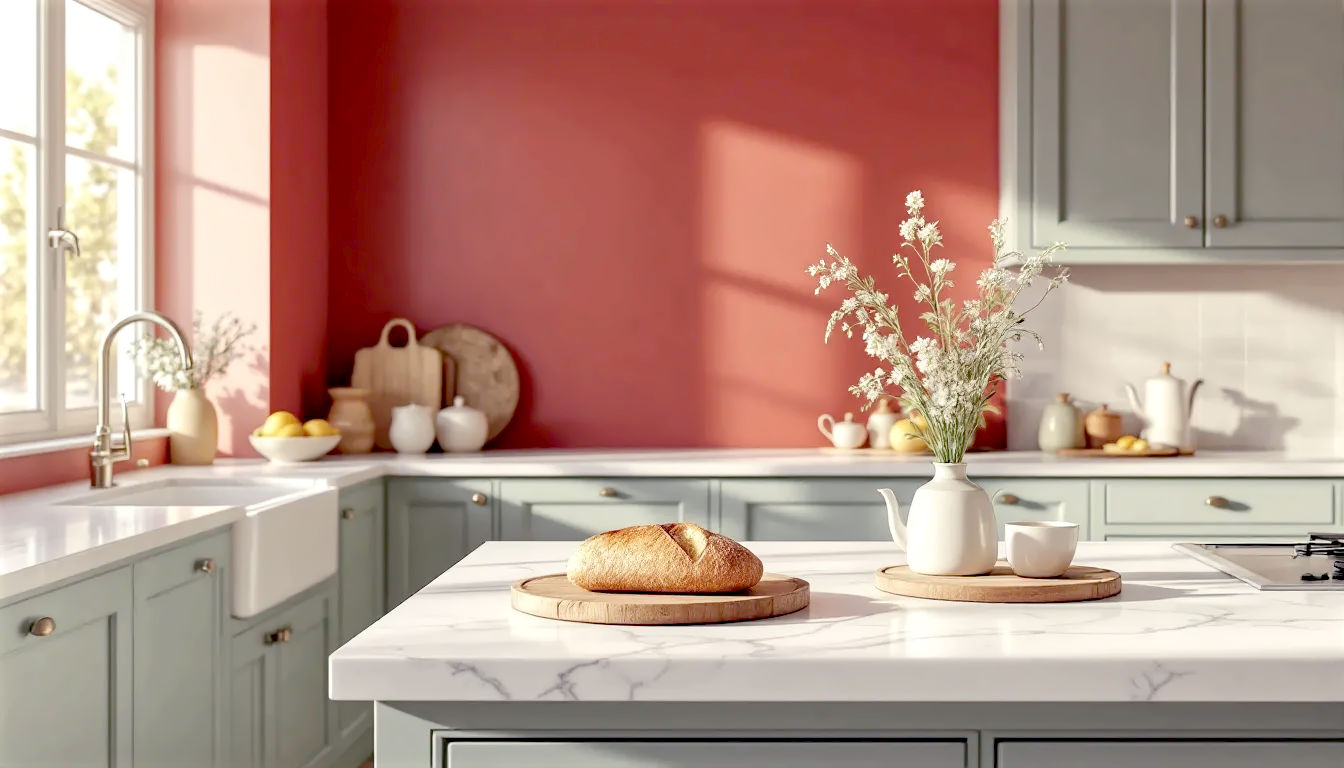The Great British Worktop Debate: Your Definitive Guide to Choosing the Perfect Kitchen Surface
Confused by kitchen worktops? Our ultimate guide demystifies the options, from budget-friendly laminate to luxury quartz, helping you find the perfect surface.

This post may contain affiliate links. If you make a purchase through these links, we may earn a commission at no additional cost to you.
The kitchen worktop. It’s more than just a slab of material where you chop your onions and spill your tea. It’s the unsung hero of the British home. It’s the stage for birthday cake icing, the makeshift home office, the leaning post for a heart-to-heart over a cuppa, and the silent witness to countless culinary triumphs and disasters. Choosing one is a massive decision, not just for your wallet, but for the very soul of your kitchen.
But ask a simple question—”What’s the most popular kitchen worktop?”—and you’ll unleash a storm of opinions. Your mate Dave will swear by his indestructible granite. Your sister insists her oak worktop is the warmest, most wonderful thing she’s ever owned. Meanwhile, a glossy magazine will tell you that you’re simply not living if you don’t have a seamless quartz island the size of a small car.
So, what’s the real story? What are most people in the UK actually putting in their kitchens?
The truth is, there isn’t one single winner. Instead, there’s a heavyweight title fight going on between two materials, each championing a different corner of the ring: Laminate, the budget-savvy king, and Quartz, the durable modern monarch.
This guide will take you through everything. We’ll break down the main contenders, explore the dark horses, and give you the honest, no-nonsense advice you need to find the perfect worktop for your home, your family, and your budget. Let’s get stuck in.
The Main Event: A Tale of Two Titans
For decades, if you wanted a new worktop without remortgaging the house, the answer was laminate. But in recent years, quartz has exploded in popularity, offering a premium, hard-wearing alternative that has truly captured the nation’s imagination. Let’s see how they stack up.
The People’s Champion: Laminate Worktops
If kitchen worktops were cars, laminate would be the Ford Fiesta. It’s affordable, it comes in every colour and style imaginable, and it gets the job done reliably for millions of people across Britain.
So, what is it, really? Think of laminate as a sort of high-tech sandwich. The middle is a slab of chipboard or MDF. The top layer, the bit you see, is a sheet of plastic laminate—which is essentially layers of paper and resin fused together under high pressure. A decorative paper gives it its colour or pattern (from a convincing wood-effect to a sparkly stardust finish), and a tough, clear topcoat gives it protection.
It was popularised by brands like Formica back in the post-war years, bringing a splash of colour and easy-to-clean convenience to the modern British kitchen. For a long time, it was seen as a bit naff, a cheap-and-cheerful option with visible dark lines and easily chipped edges. But things have changed.
Modern, high-pressure laminates are worlds away from their ancestors. The printing technology is so good that they can mimic stone, wood, and concrete with astonishing realism. You can get squared edges, curved edges, and textures that feel like real wood grain or cool stone.
Why It’s Still So Popular:
- The Price Tag: This is laminate’s superpower. It’s by far the most budget-friendly option. For the price of a small section of granite, you can often fit out your entire kitchen in high-quality laminate. This frees up cash for those fancy taps or the induction hob you’ve been dreaming of.
- A Chameleon of Style: Seriously, you can get it in any look. Want the Scandi vibe of pale wood without the hassle of oiling? Done. Fancy the dramatic dark veins of marble without the fear of red wine stains? No problem. It allows you to follow trends without a massive financial commitment.
- Easy Peasy Installation: It’s lightweight and can be cut on-site with standard tools, making it a favourite for DIYers and kitchen fitters alike. You don’t need a specialist team of stone masons to get it installed.
- Low Maintenance: A simple wipe with a damp cloth and a bit of washing-up liquid is all it needs. No sealing, no special potions, no fuss.
The Not-So-Good Bits:
- It Hates a Hot Pan: Never put a hot pan directly onto a laminate worktop. The heat can melt the resin, leaving a permanent blister or scorch mark. A trivet is your best friend.
- Not a Fan of Sharp Knives: While the top layer is tough, it’s not invincible. Chopping directly on the surface will leave cut marks that can’t be repaired. Always use a chopping board.
- Water is its Kryptonite: The surface itself is waterproof, but the chipboard underneath is not. If water gets into the seams or a chip on the edge, the chipboard can swell up like a sponge, ruining the worktop. This is why well-fitted joints and sealed edges are absolutely critical.
- It Can’t Be Repaired: A deep scratch or a burn is there for good. Unlike wood or solid surface materials, you can’t just sand it out.
The Verdict on Laminate: Laminate is the undisputed king of value. It’s perfect for first-time buyers, rental properties, utility rooms, or anyone doing a stylish kitchen makeover on a tight budget. Modern designs look fantastic, but you have to accept its limitations and treat it with a bit of care.
The Modern Monarch: Quartz Worktops
If laminate is the sensible Fiesta, quartz is the sleek, high-performance German saloon. It looks the business, it’s packed with technology, and it’s become the go-to choice for the modern, aspirational British kitchen.
So, what is it, really? This is where people often get confused. Quartz worktops aren’t a solid slab of stone dug out of a mountain. They are an engineered stone. Think of it like this: nature provides the ingredients, and science perfects the recipe.
They are made from about 90-95% crushed natural quartz (one of the hardest minerals on Earth) mixed with a small amount of polymer resin to bind it all together, and pigments for colour. This slurry is poured into a mould, compressed under immense pressure, and then baked to create an incredibly dense and durable slab.
Why It’s Taking Over:
- Tough as Nails: Because it’s engineered, quartz is exceptionally hard. It’s highly resistant to scratches, chips, and impacts. It’s not indestructible, but it will happily shrug off most of the daily abuse a busy family kitchen can throw at it.
- The Stain Slayer: This is its killer feature. Unlike natural stones like granite or marble, quartz is non-porous. This means liquids like wine, coffee, or lemon juice can’t seep in and cause stains. It also means bacteria has nowhere to hide, making it brilliantly hygienic.
- Consistency is Key: With natural stone, you get what you’re given. That slab of granite might have a huge, ugly blotch right in the middle. With quartz, the colour and pattern are consistent from one end of the slab to the other, giving a clean, uniform look that’s perfect for modern, minimalist designs.
- Endless Style Options: Just like laminate, because it’s man-made, it can be engineered to look like almost anything. You can get brilliant whites, jet blacks, and every shade of grey in between. Many designs beautifully mimic the veining of marble or the speckles of granite, giving you the look without the drawbacks.
The Not-So-Good Bits:
- The Price: Quality comes at a cost. Quartz is significantly more expensive than laminate and often pricier than entry-level granite. It’s a serious investment.
- Not Completely Heat-Proof: That resin holding it all together can be damaged by extreme heat. A sudden temperature shock from a sizzling pan can cause a “thermal fracture” or discolouration. Like laminate, you must use trivets.
- The Sun is Not Its Friend: If part of your worktop is in direct, strong sunlight for long periods, the resin can be affected by UV rays over many years, potentially causing some colours to yellow or fade. It’s more of a concern for outdoor kitchens but worth knowing.
- Heavyweight Champion: These slabs are incredibly heavy and require specialist templating and installation, which adds to the overall cost. This is not a DIY job.
The Verdict on Quartz: Quartz is the top choice for those who want a blend of stunning aesthetics and everyday practicality. It’s perfect for busy family kitchens, keen cooks who want a hygienic surface, and anyone aiming for a high-end, contemporary finish that’s built to last. It’s an investment, but its durability and low maintenance make it a justifiable one for many.
The Enduring Classics: Still Holding Their Own
While laminate and quartz battle it out for the top spot, two other materials have been gracing British kitchens for years and remain hugely popular choices, each with a passionate following.
The Timeless Original: Granite Worktops
For a long time, granite was the absolute pinnacle of kitchen design. It spoke of quality, permanence, and luxury. Each piece is a unique slice of the Earth’s history, formed from cooled magma over millions of years.
The Appeal of Authenticity:
- One of a Kind: No two slabs of granite are ever the same. The unique combination of minerals like quartz, feldspar, and mica creates an incredible depth of colour and pattern, from subtle speckles to dramatic, sweeping veins. Your worktop is literally a piece of natural art.
- It Can Take the Heat: As an igneous rock, granite is formed by intense heat. It can handle a hot pan placed directly on its surface without a problem, making it a favourite of serious cooks.
- Hard as a Rock (Literally): It’s incredibly scratch-resistant. You’d have a hard time damaging it with a knife, though you would blunt your knives very quickly!
The Practical Considerations:
- The Sealing Ritual: Granite is naturally porous, a bit like a stone sponge. If you don’t seal it properly and regularly (usually once a year), it will drink up spills. A drop of oil or a splash of red wine can leave a permanent stain.
- It Can Chip or Crack: While tough, a heavy blow in just the right spot (especially on an edge or corner) can cause a chip or crack. Repairs are possible but can be tricky and expensive.
- The Cost and Weight: Like quartz, granite is expensive and very heavy, requiring specialist installation. The price can vary wildly depending on the rarity and origin of the stone.
The Verdict on Granite: Granite is for the purist who loves natural beauty and wants a truly unique centrepiece for their kitchen. It’s perfect for traditional, farmhouse, or high-end kitchens where its character can shine. If you’re prepared for the small amount of maintenance it requires, it will reward you with a timeless surface that lasts a lifetime.
The Rustic Favourite: Solid Wood Worktops
There’s an undeniable warmth and charm to a solid wood worktop. It feels alive, it’s warm to the touch, and it brings a beautiful slice of nature right into the heart of your home. Oak, beech, walnut, and iroko are all popular choices in the UK.
The Beauty of a Living Surface:
- Ages Gracefully: A wooden worktop develops a story over time. The small marks and changes in colour build a rich patina that adds to its character. Many people feel it just gets better with age.
- Repairable and Forgiving: This is wood’s secret weapon. Got a nasty scratch or a stubborn stain? You can simply sand it down and re-oil it, making it look as good as new.
- Naturally Antibacterial: Studies have shown that wood has natural properties that can kill bacteria, making it a surprisingly hygienic choice when properly maintained.
- Affordable Charm: Compared to stone, solid wood can be a very cost-effective way to get a premium, natural material in your kitchen.
The Demands of Maintenance:
- Thirsty for Oil: This is the big one. A wooden worktop needs regular oiling to keep it waterproof and protected. When you first install it, you’ll need to do several coats. After that, you’ll need to top it up every 3-6 months. If you don’t, water will seep in, causing ugly black stains, especially around the sink.
- It Scratches and Dents: Wood is soft. It will mark. For many, this is part of its charm. For others, it’s a nightmare. You have to be prepared to embrace the “lived-in” look or be ready to do some sanding.
- Sensitive to Heat and Water: You can’t put hot pans on it, and you must wipe up spills immediately. Standing water is its worst enemy.
The Verdict on Solid Wood: A solid wood worktop is a lifestyle choice. It’s for the person who enjoys the process of caring for natural materials and loves the warm, rustic aesthetic. It’s perfect for country kitchens, traditional homes, and anyone who wants a surface with real heart and soul. If you’re a low-maintenance kind of person, it’s probably best to steer clear.
The Supporting Cast: Other Materials to Consider
While the big four dominate the market, there are other options out there, each with its own unique strengths.
- Solid Surface (e.g., Corian, Minerva): An acrylic-based material that can be moulded into seamless shapes. Sinks can be integrated without any joins, making it super hygienic. It’s soft and can scratch, but like wood, scratches can be sanded out. It sits somewhere between high-end laminate and quartz in price.
- Sintered Stone (e.g., Dekton, Neolith): This is the next generation of engineered surface. It’s made from natural minerals fused together under extreme heat and pressure, mimicking the formation of natural stone but in a factory. The result is an ultra-compact material that is virtually indestructible—it’s incredibly resistant to heat, scratches, and stains. It’s also very expensive.
- Marble: The epitome of luxury and classic beauty. However, it’s a terrible choice for most kitchens. It’s soft, porous, and stains if you so much as look at it with a lemon. Best saved for show kitchens or keen bakers who want a dedicated cool surface for rolling pastry.
- Stainless Steel: The choice of professional chefs for a reason. It’s heat-proof, totally non-porous, and hygienic. But it scratches very easily (developing a patina of fine scratches over time), shows every fingerprint, and can look cold and clinical in a home setting.
- Concrete: For a raw, industrial, urban look, a polished concrete worktop makes a real statement. It’s custom-made, incredibly heavy, and needs to be sealed meticulously to prevent staining. It can also develop hairline cracks over time, which some see as part of its character.
How to Choose Your Perfect Worktop: A Practical Guide
Feeling overwhelmed? Don’t be. Choosing the right worktop comes down to being honest about three things: your budget, your lifestyle, and your style.
1. Be Brutally Honest About Your Budget
Your budget is the biggest factor. Remember to account for not just the material itself, but also templating, delivery, and installation, which can add a significant amount to the final bill for stone and solid surfaces.
- £ (Most Affordable): Laminate, some entry-level Solid Wood.
- ££ (Mid-Range): High-end Laminate, most Solid Wood, Solid Surface, entry-level Granite and Quartz.
- £££ (Premium): Mid-to-high-end Granite and Quartz, Sintered Stone, Concrete, Marble.
2. Think About Your Lifestyle
How do you actually use your kitchen?
- Busy Family with Young Kids? You need something bomb-proof and low-maintenance. Quartz is a fantastic choice, as is high-quality laminate. They can handle spills, sticky fingers, and the general chaos of family life.
- Passionate, Messy Cook? Hygiene and stain resistance are key. Quartz and stainless steel are top contenders. Granite is great for heat resistance, as long as you’re diligent with sealing.
- Careful, Tidy, and House-Proud? If you’re the sort of person who wipes up spills immediately and always uses a chopping board, your options are wide open. You could happily live with the demands of solid wood or even marble.
- Doing it for the Resale Value? If you’re renovating to sell, a neutral, crowd-pleasing option is best. A simple white or light grey quartz or a high-quality, modern laminate will appeal to the most buyers.
3. Match it to Your Kitchen Style
The worktop needs to work with your cabinets, floor, and the overall feel of your home.
- Modern & Minimalist: Quartz with its clean lines and consistent colours is a natural fit. Sleek, handleless cabinets with a simple white or grey quartz worktop is a timeless modern look. Sintered stone or concrete also work well.
- Traditional & Country: Solid wood is the obvious choice for warmth and character. A classic granite with a detailed edge profile also looks fantastic with shaker-style cabinets.
- Industrial: Think concrete, stainless steel, or a laminate/quartz that mimics a raw material like rusted metal or dark slate.
- Eclectic & Bold: This is where you can have fun! A brightly coloured laminate, a dramatically veined granite, or a terrazzo-style quartz can become the star of the show.
The Final Word
So, what is the most popular kitchen worktop in Britain?
If we’re talking sheer numbers, budget-friendly laminate is still the volume seller, fitted in countless new builds and kitchen refits across the country. But if we’re talking about what people want, what they aspire to, and what they are increasingly choosing to invest in for their forever homes, then quartz is undeniably the new king of the castle.
Ultimately, though, the “best” worktop is the one that fits seamlessly into your life. It’s the one that makes you smile when you walk into your kitchen in the morning to put the kettle on. Whether it’s the honest simplicity of wood, the unique story of granite, the smart value of laminate, or the sleek resilience of quartz, the perfect surface for you is out there. Choose wisely, and it will serve you faithfully for years to come.
Further Reading
For more detailed research, technical specifications, and inspiration, these resources are highly respected in the UK:
- Which? Kitchen Worktop Buying Guide: The consumer champion provides impartial, in-depth tests on durability and stain resistance.
- Ideal Home – Kitchen Worktop Guide: A fantastic resource for style inspiration and practical advice.
- Grand Designs Magazine: For those looking at high-end, innovative, and bespoke worktop solutions.
- Houzz UK: A vast gallery of real British kitchen projects where you can see how different worktops look in practice.






